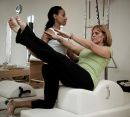Pilates – Core Strength

Core strength, which is the powerhouse for the rest of your body, is created by exercise. When you have attained a level of understanding about core strength, Pilates start to feel like an altogether different form of exercise, you will begin to get a feel of your body in a focussed, and concentrated way. The centre of the body is formed by the abdominals and the back, from which all the Pilate movements are initiated. If you notice a ferris wheel in a fun fair, you will find the wheel moving but the powerhouse is the centre because it is the central controlling power. This is the way your body works. You should concentrate on the centre of your body, because without sufficient strength in the centre, the whole system gets weak and breaks down, making the body vulnerable.
Muscles That Stabilize The Torso:
Rectus abdominis: This is a wide and long muscle that runs all the way down from the sternum that is the breast bone to the pubic bone. The rectus abdominis helps to maintain correct posture and allows forward flexion.
Obliques: These are located at the waist, and are two sets: the internal and external obliques. They allow you to rotate at the waist as well as flexing laterally.
Transverse abdominis: This muscle is located behind the rectus abdominis, like a ‘girdle’ wrapped around your stomach. It is used when you draw your navel towards your spine, and is the muscle that contracts when you cough.
Building Core Strength:
By stabilizing the torso you are creating a co-contraction between the abdominal muscles and the back muscles. It means all the muscles work together to create a stable entity. Back muscles mostly are tight and weak in most people. What happens is that the spine may get out of alignment, causing pain, risk of injury and bad posture. When the back muscles are strong and flexible, it becomes easy to get a good posture. Pilates help to attain that correct posture by stretching the core muscles, helping to correct imbalances and stop suffering with pain in the back.